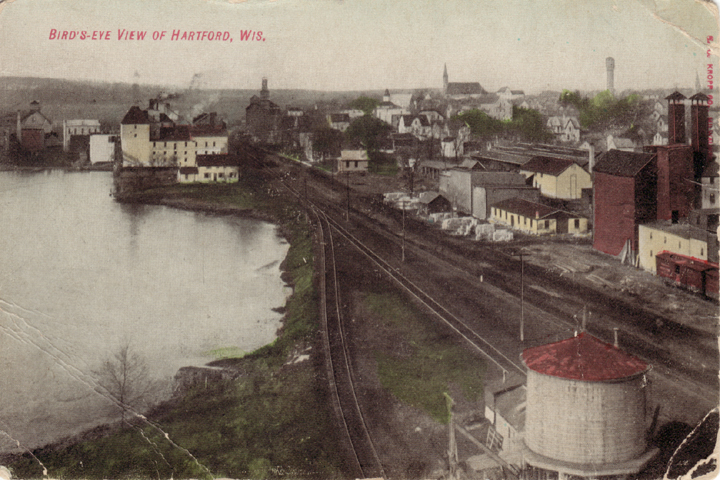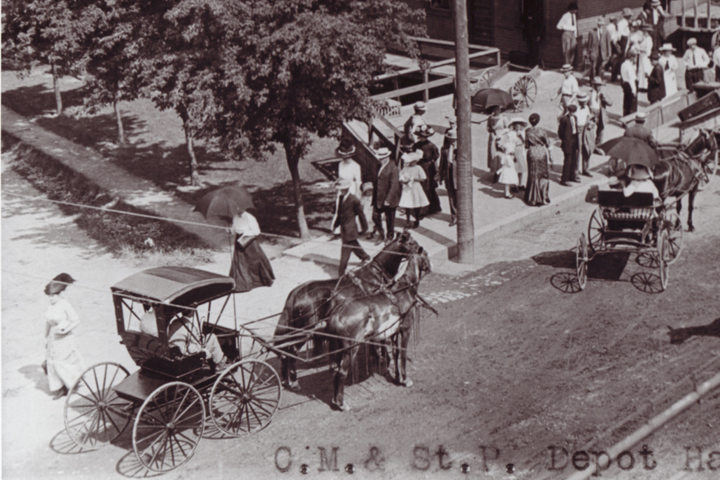
In 1838, two years after the Wisconsin Territory was established, the boundaries of Washington county were set by surveyors, identifying it as "Town 10, Range 18 East." Potawatomi and Winnebago Indians, who had ceded their land in 1833 and moved west to the Mississippi River, had begun to filter back to their traditional hunting grounds. In 1843, some 100 Potawatomis lived on the east shore of Pike Lake and had friendly relations with the early settlers had come to the frontier from the east. By 1850, mass immigration from Ireland and central European nations was beginning. The Hartford area saw thousands of these hardworking settlers arrive in search of a new and better life, taking up homesteads and establishing businesses in Hartford and settlements like Germantown and Erin Township.
Among them were John Thiel, from Germany, and Nicolas Simon, from Prussia, who arrived in 1844. History credits these two surveyors with being the first to plat what is now Hartford in 1844. Simon's description of the place he and Thiel had found attracted James and Charles Rossman who immediately purchased 40 acres around the rapids of the river that flowed through the area and constructed a dam. Later, the Rossman's built a grist mill.
The settlement that grew around the dam and grist mill became known as Rubicon, after the river, but later Wayne, Benton, and Wright were considered as names for the community. In 1847, the name Hartford was chosen, it is said by the toss of coin, after Hartford, Connecticut. Hartford was incorporated as a village in 1871 and a dozen years later, with the population at 1,500, became a city.

In 1866, William B. Place settled in the community and opened a tannery. W.B. Place & Company's tannery and retail store still sells quality leather goods. The community's first school was established in 1845. A 19-year-old named Gad Root offered his services as a teacher and was hired at $14 per month. His first class had 25 pupils. The settlement's first organized church was the Congregational Church which held its first services in 1847. The congregation met in the school until 1853 when James and Charles Rossman donated a half-acre for the construction of a church building. By 1883, Hartford had two schools and six churches.
Shortly after the turn of the century, the Kissel Motor Car Company was established in Hartford. Organized by Louis Kissel and his sons, the company built automobiles until the Great Depression hit the nation. In 1912, the company employed some 1,000 employees. Its two most famous vehicles were the 1919 Goldbug Speedster and the 1927 White Eagle. In 1931, the company was reorganized as Kissel Industries to build outboard motors for Sears, Roebuck and Company. It was later sold, first to West Bend Aluminum, then to Chrysler Corp. Picture below is Early Main Street Hartford, Wisconsin.

Of course the Rails always were important in the development of a community

As I look at this picture it brings back so many memories with Grampa Frank
He would back in where you see the truck at the right of the picture
He would pick up the US Mail from the train and bring it to the Post Office
And this is the way I remember the train station with the little steel wheeled carts
On the platform that is where they put the mail to haul to the waiting truck.

Looking East from the western end of the Platform on both pictures.

I remember just to the right in this picture were the coal bins that was used to
Heat the businesses on Main Street there was a central heat system back then
That supplied steam heat to all of main street.
An just beyond these coal bins were the building of the Hartford
Street department when Dad worked for so many years.

This was looking West along the ole Mill pond Building on extreme left
side of picture was the City Hall and Fire Station
Rails were laid for the Milwaukee LaCrosse line in 1855.
This was the main line
between Minneapolis and Chicago until the
early 1900ís when the route between
Oconomowoc and Portage was double
tracked.

This was a gathering near the Train Depot.

This was city hall and the fire station engines coming right out to Main Street.

Picture of the Hartford Fire Fighters out side the Fire Station.

Looking West on State Street from Main Street.

Looking North from Union Street, North Main Street
believe Steeples are the Peace Lutheran Church

The Old Mill Dam on the Rubicon River
James and Charles Rossman accompanied
Nicolas Simon
back to Hartford and immediately bought
forty
acres around the rapids of the river.
They
started construction of the dam around
1844,
soon after moving here. The dam remains
here
today in the area of East Jackson Street.
The
construction of Rossmanís Saw Mill on the
Rubicon River accounted for the steady
growth
of Hartford.

Now Main Street use to be a beehive of activity
This is looking South from the City Hall
The Young-Luttropp Co. was later the home of Sears Roebuck & Co.
The Streets were cobble Stone, the buildings heated by a central plant.

The Kissel Motor Car Factory in Hartford consists of 15 buildings, constructed between 1905 and 1920. The first buildings in this district were constructed for the production of the Kissel Gasoline Engine. In 1906 the decision was made to begin producing automobiles and an additional building, measuring 112 feet by 160 feet, was constructed. Almost yearly through 1920, new buildings were constructed and existing buildings were expanded to accommodate the growing business. In early 1920s, the company employed over 1200 people. Largely as a result of the success of the Kissel business,Hartford's population nearly tripled between 1900 and 1920 and the city grew from small agricultural support community to a large manufacturing center. The two most famous automobiles produced at the plant were the 1919 Goldbug Speedster and the 1927 White Eagle.

1919 Goldbug Speedster
